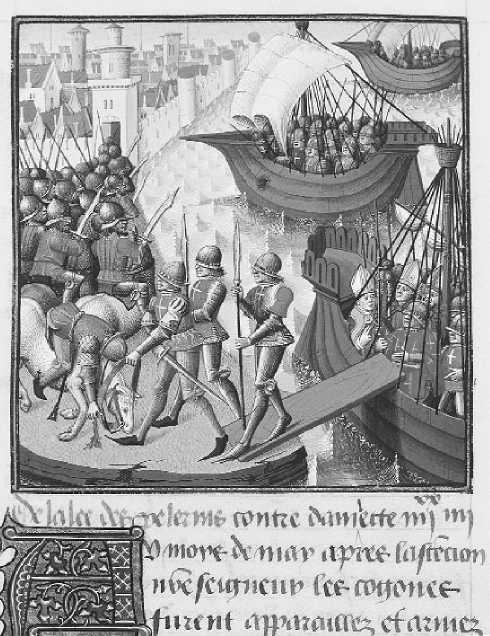A port (mod. Dumyat, Egypt) on the eastern portion of the Nile Delta, boasting triple walls and a tower that controlled access to the upper Nile by means of a chain stretched across the river to the city walls.
In 1169 Damietta was besieged by King Amalric of Jerusalem and the Byzantine emperor Manuel I Komnenos during their attempt to seize control of the Fatimid realm. Regarded as the “key to all Egypt,” Damietta became the initial target of the Fifth Crusade (1217-1221), although the crusaders’ intentions toward the city appear to have evolved during the course of their campaign. Some seem to have considered it and other potential acquisitions in Egypt as pawns to be traded for territory lost in the kingdom of

Entry of the Crusaders into Damietta, 1249. Illustration from Le Miroir Historial (The Mirror of History), by Vincent de Beauvais (1190-1264). (Archivo Iconografico, S. A./Corbis)
Dandolo, Enrico (d. 1205)
Jerusalem, while others viewed Damietta as a beachhead for the permanent conquest and colonization of Egypt.
After a siege of fifteen months, the crusaders captured the city in November 1219, a plague having ravaged its inhabitants. The port and its spoils, including the towers guarding its walls, were partitioned among the regional groups present in the army, although not without serious dispute. The overlordship of the city sparked a struggle between the papal legate Pelagius, who wanted to reserve it for the titular, albeit absent head of the crusade, Emperor Frederick II, and John of Brienne, who claimed it for the kingdom of Jerusalem. After John was granted temporary custodianship, the city’s mosques were converted into churches, including a cathedral for a newly created archbishopric.
The crusaders repeatedly rejected truces proposed by the sultan of Egypt, al-Kamil, offering the return of Jerusalem and major fortresses west of the Jordan in return for the Christian army’s withdrawal, partly due to his exclusion of the castles of Kerak and Montreal, considered essential to hold Jerusalem. However, after the crusader army advanced toward Cairo, it suffered devastating losses and was forced to surrender Damietta to al-Kamil in 1221.
Perhaps influenced by the advice of John of Brienne, King Louis IX of France also made Damietta the initial goal of his crusade against Egypt (1248-1254), taking it in 1249. After Louis and his army were captured by the Egyptians in the spring of 1250, however, the city was returned to Muslim hands as part of the staggering ransom demanded for their release. It was razed shortly thereafter to prevent the vulnerable port from being used as a foothold for future crusader offensives.
-Jessalynn Bird
See also: Crusade of Louis IX to the East (1248-1254); Egypt
Bibliography:
Phillips, Jonathan, Defenders of the Holy Land: Relations between the Latin East and the West, 1119-1187 (Oxford: Clarendon, 1996).
Powell, James M., Anatomy of a Crusade, 1213-1221 (Philadelphia: University of Pennsylvania Press, 1986).
Richard, Jean, Saint Louis. Crusader King of France (Cambridge: Cambridge University Press, 1992).




 World History
World History









